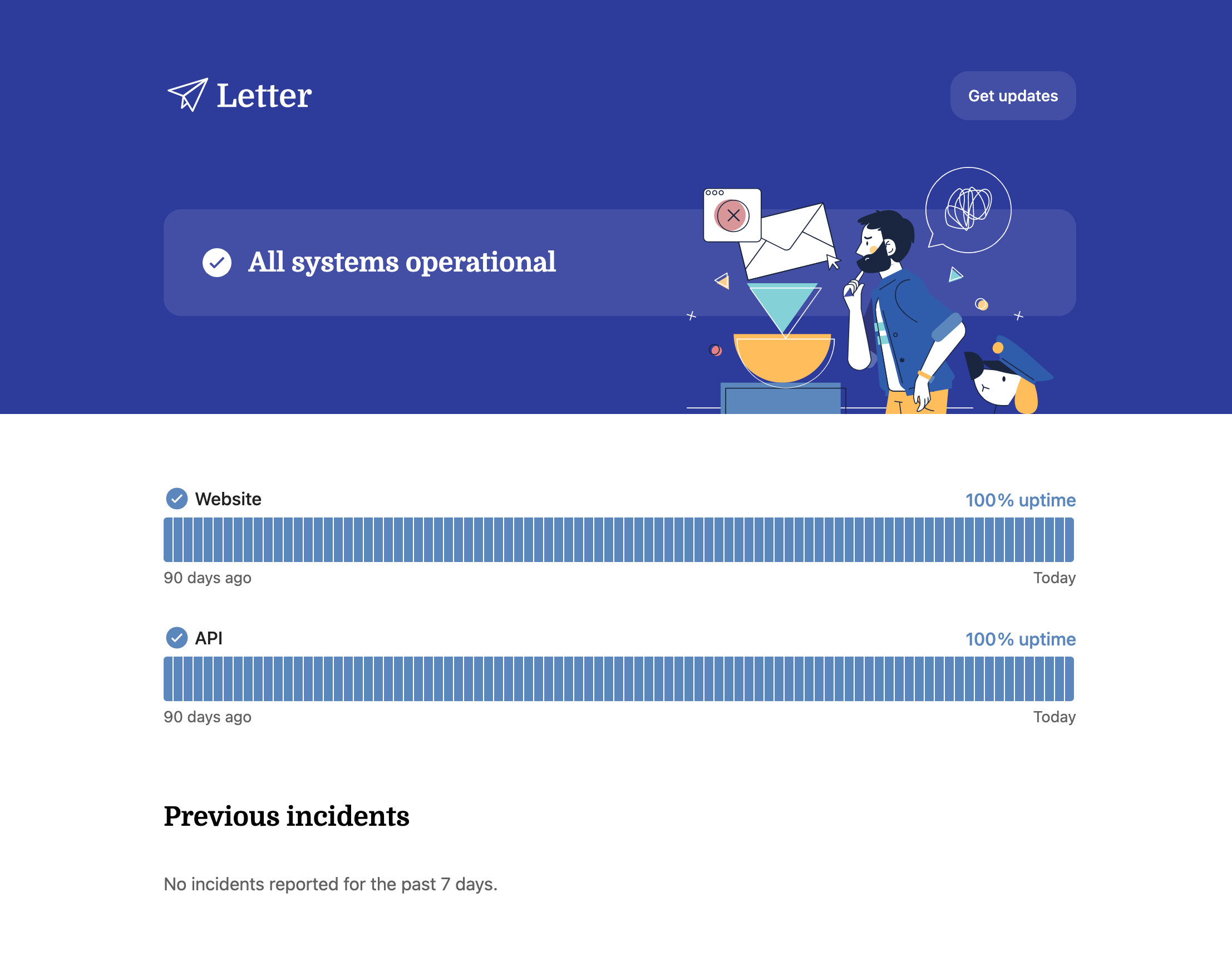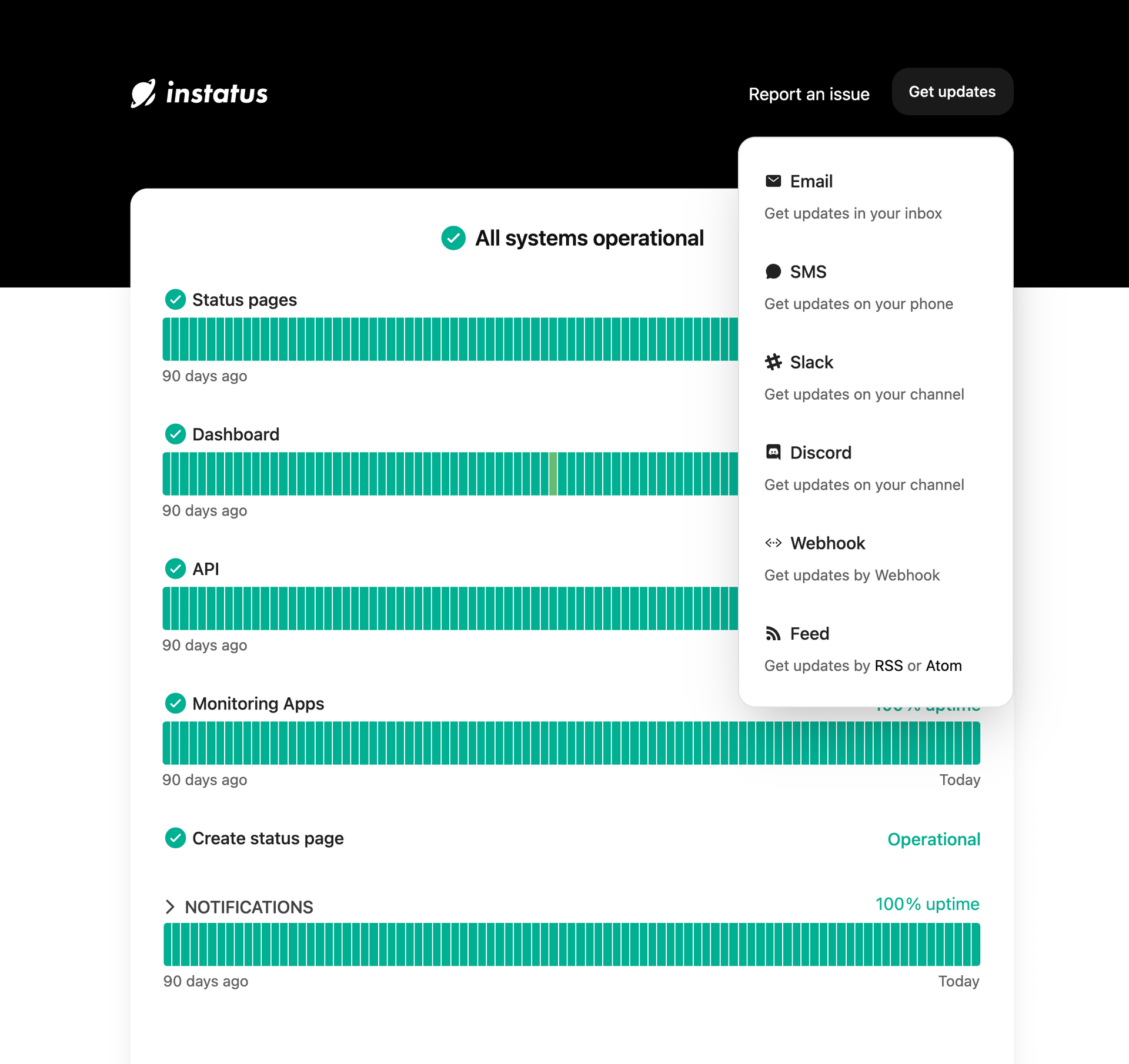Mean Time To Failure (MTTF) - The Complete Guide

Mean Time To Failure (MTTF) is a metric used by many companies who worry about online asset failure and software reliability. Companies have a responsibility to ensure that their software remains operational at all times in order to meet customer demands, so maintenance must be carried out efficiently to prevent performance issues from occurring.
It’s important for companies to let customers know when software maintenance is being carried out, so most companies use tools like Instatus to set up status pages, which inform customers on scheduled maintenance, server statuses, and the operational status of services like storefronts and customer support.
Mean Time To Failure is one of many metrics for measuring an asset’s performance and can help companies plan for maintenance effectively.
What Is Mean Time To Failure (MTTF)?
Mean Time To Failure, which is also known as MTTF, is one of the various metrics used in software reliability checks. Mean Time To Failure is essentially a method for testing how long a non-repairable asset can last before it stops operating correctly and encounters performance errors.
A non-repairable asset refers to any device or software that’s easily replaceable or can’t be repaired. MTTF is usually used in conjunction with other software maintenance metrics, such as MTBF, MTTR, and MTTD.
In order to calculate Mean Time To Failure, experiments must be carried out first to test an asset’s operation time.
Why Is It Important To Calculate Mean Time To Failure?
Time-Efficiency
Mean Time To Failure calculations can save you a lot of time and labor. It can be difficult to carry out maintenance plans efficiently if you’re unsure about how long an asset will actually last. Mean Time To Failure can give an estimate of an asset’s total operation time, which makes it easier to schedule maintenance.
For example, if a system lasts for an average of 1000 hours, you can plan system replacements to take place before those 1000 hours are up.
Cost-Efficiency
You can calculate MTTF to find out how often an asset will need replacing. This can help you set budgets and create asset replacements as preparation for planned maintenance. You can also use MTTF to determine whether an asset should be deemed non-repairable. If an asset fails frequently, the cost of repairs likely exceeds the cost of replacements.
You can also experiment with new software assets and use MTTF to calculate whether it extends the original operation time. This will save you money because an asset will require less frequent replacements.
Improves Maintenance
You can use MTTF to help plan for replacements more efficiently. If you know when an asset is likely to fail, you can prepare for replacements close to that time. You can prioritize asset replacements according to their MTTF.
Tests Reliability
MTTF also tests the reliability of an asset. When you’re testing how long multiple copies of the same asset last, you can compare the different operation times and check similarities and differences. The more similar they are, the more reliable an asset is.
A reliable asset is unlikely to experience unexpected failures, which reduces the likelihood of sudden server outages or software errors. These can be detrimental if your software offers a crucial service to your customers, such as CRM tools or asset management software.
If an asset seems unreliable, it’s best to prepare backup assets in case of emergency maintenance procedures. In these cases, it helps to have a status page, which you can get using Instatus, to keep customers in the loop and maintain a good user experience.
How Do I Calculate Mean Time To Failure?
Mean Time To Failure calculation for software may seem like a daunting task, but it’s actually a very simple process. It mainly consists of two parts: the testing phase and the calculation phase. The testing phase can take up a lot of time, so make sure you have the funds to carry it out before you start.
Step 1: Test An Asset’s Lifespan
In order to calculate Mean Time To Failure, you must first carry out an experiment. Choose a non-repairable asset to experiment with, and get multiple copies of that asset. You can test them all simultaneously or test them one by one.
For example, take 5 of the same operating system and test them all on the same type of device. Use them until they fail and document the times of failure. Make sure you note down their starting times as well so you can accurately calculate how long they operate for. We find that measuring in hours is the easiest metric for time.
How To Test For Software Failure
Failure can mean different things depending on the software you’re testing. To quantify what failure means for your software, identify the specific requirements your software must meet in order to be deemed operational. If those requirements are not met, your software has failed.
Types Of Software Testing:
Unit Testing
This involves testing specific components of a software, which are also known as units. Isolate a piece of code and test its functionality until it fails.
Integration Testing
Combine all software units and test them as a whole until failures occur. This allows you to see if the MTTF of individual units differ when operating together.
System Testing
Test software in its usual operating state to check the MTTF of entire systems, such as customer portals.
Regression Testing
When a new feature is added, it may cause other features or systems to fail unexpectedly. Regression testing involves testing the entire software and its different systems again, but this time with the new feature in place.
Step 2: Calculate The Total Time Of Operation
After conducting the experiment, add up all of the assets’ operation times to get the total operation time.
Step 3: Calculate The Average Operation Time
Finally, it’s time to get the average operation time. Divide the total hours of operation by the total number of assets used in the experiment. The answer is the Mean Time To Failure.
The Mean Time To Failure formula is as follows:
Mean Time To Failure = Total time of operation ÷ total number of assets in use
For example:
Total time of operation = 1000 hours
Total number of assets in use = 20
Average operation time = 1000 hours ÷ 20
MTTF = 50 hours
Keep in mind that MTTF is only an estimate and isn’t completely accurate. You can conduct further experiments to get a better average.
How Do I Improve Mean Time To Failure?
Now it’s time to discuss how to actually improve Mean Time To Failure for your software assets, which can help elevate your overall performance and maintenance strategies. There are several methods you can use to increase your MTTF:
Find The Root Cause Of Failure
Finding out the root cause of failure is the first step towards extending MTTF for an asset. If you know what’s causing a failure, you can fix the issue and prolong an asset’s lifespan as a result. You can use Root Cause Analysis (RCA) to find out why your software failed to operate correctly and ways to fix that problem.
RCA Steps:
- Identify the failure and collect relevant data (e.g. bug reports from users)
- Determine reasons for failure and the root cause (there are usually multiple causes)
- Come up with maintenance strategies to fix the cause
- Analyze the effects of those strategies (both good and bad)
- Design and implement those strategies
- Do system testing and user testing to check for errors
- Launch a software update including the new changes
Use The Four Types Of Software Maintenance
There are four main types of software maintenance you can carry out to improve your assets’ lifespans:
Preventive Software Maintenance
This is maintenance that's carried out regularly to prevent major performance errors, which can extend an asset’s lifespan in the long run. Examples include fixing small bugs and updating plugins.
Adaptive Software Maintenance
This is a more extreme method of maintenance, which requires changing the type of assets you use to improve overall lifespan. For example, you can change the operating system, storage system, operating platform, etc.
Corrective Software Maintenance
This is the most basic form of software maintenance, which consists of identifying faults and fixing them as quickly as possible. It’s best to fix them before users can discover them to prevent performance interruptions.
Perfective Software Maintenance
This is a more passive form of maintenance, which requires adding or removing features according to user feedback. This can help inform you on what assets to calculate MTTF for and which assets no longer need that calculation.
Keep Customers Informed
A status page can also inform customers about possible server shortages and interruptions when maintenance is being carried out. If customers are unable to access your service or they experience major lagging, they should know why that’s happening. A status page can alleviate your customers’ worries and increase their trust in a company.
How To Get A Status Page
You can easily get a free status page using Instatus, which keeps your customers in the loop while maintenance is being undertaken, vastly improving user experience.
A status page should include:
- Server status
- Operational status
- Different systems (e.g. storefront, checkout)
- Server Outages
- Performance issues
- Maintenance schedules
Conclusion
Mean Time To Failure is a software maintenance metric for measuring how long a non-repairable asset will last in operation before it needs replacing. MTTF is calculated by taking the total operation time and dividing it by the number of assets used. You can use MTTF to inform you when maintenance should be scheduled and when replacements should be prepared.
It’s best to let customers know about your maintenance schedule using a status page to reduce complaints and build trust in your company. You can get a free status page in just 10 seconds using Instatus, which is an online tool that creates status pages for you. Get your free status page today for free and keep your customers informed.
Get ready for downtime
Monitor your services
Fix incidents with your team
Share your status with customers



